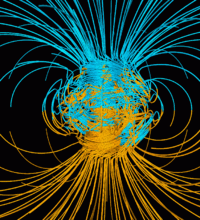
Photo from wikipedia
We describe detailed magnetic and bathymetric studies around 13°N on the Mid‐Atlantic Ridge, a site of extensive detachment faulting. Inversion of closely spaced sea surface magnetic anomalies reveals a disorganized… Click to show full abstract
We describe detailed magnetic and bathymetric studies around 13°N on the Mid‐Atlantic Ridge, a site of extensive detachment faulting. Inversion of closely spaced sea surface magnetic anomalies reveals a disorganized pattern of magnetization, with anomalies younger than anomaly 2 being poorly delineated. The Brunhes anomaly width is highly variable but averages ~60% of that predicted for the regional spreading rate. It is often split, both along and across axis, by apparently reversely magnetized crust. Gaps in the Brunhes anomaly match gaps in the neovolcanic zone inferred from acoustic backscatter. A strong negative magnetization is associated with the oceanic core complex (OCC) at 13°20′N (OCC1320) and is inferred to arise from exhumed old, reversely magnetized lithosphere. The inferred position of the magmatic axis implies ~30% asymmetry of crustal accretion post‐anomaly‐2. Higher spatial resolution magnetic anomalies near the seafloor, measured by autonomous underwater vehicle, are qualitatively similar to earlier deep‐towed data but differ somewhat from the sea surface magnetics. We interpret this mismatch as reflecting the differing sensitivities of the two observing geometries and the existence of a highly heterogeneous topography and magnetization. This suggests that a strongly three‐dimensional structure exists, more compatible with a geodynamic model where neighboring OCCs are not connected but evolve independently. A modeled near‐seafloor profile through OCC1320 shows low positive magnetization below the smooth dome. A second profile, running E‐W between two OCCs, shows high magnetization coinciding with a large seamount, reflecting recent off‐axis volcanism. Measured microbathymetry reveals extensive small volcanic cones on this seamount and confirms previous interpretations of OCC morphology.
Journal Title: Geochemistry, Geophysics, Geosystems
Year Published: 2019
Link to full text (if available)
Share on Social Media: Sign Up to like & get
recommendations!